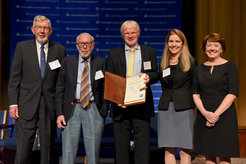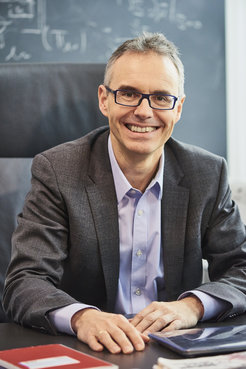Max Planck – New York City Center for Non-equilibrium quantum phenomena inaugurated
Max Planck Society, Columbia University and Flatiron Institute launch new joint research center

Together, the center’s scientists will study quantum materials that are not settled into a stable state. Scientists can perturb materials through methods such as electric currents, heat pulses, barrages of photons or by embedding them in quantum cavities.
Once out of equilibrium, a material may exhibit new properties such as magnetism, ferroelectricity or superconductivity. If scientists could carefully control this process, they could design materials for wide-ranging and potentially revolutionary applications, including quantum computing.

The New York Center unites the complementary research strengths of its four partner institutions. It will be led by the MPSD’s managing director Andrea Cavalleri and Dmitri Basov, Higgins Professor of Physics at Columbia University. MPSD Theory director Ángel Rubio and Andrew Millis, the Co-Director of the Flatiron Institute’s Center for Computational Quantum Physics (CCQ), are the Center’s deputy co-directors.
Representatives of the three institutions joined an internationally renowned group of scientists for the opening event at Columbia University on November 18, followed by a two-day scientific symposium and workshop hosted at the Flatiron Institute.
Andrea Cavalleri said: “This center will greatly enrich the research already carried out on the properties of quantum materials by combining theoretical and experimental methods. It will also make a significant contribution to the training of young scientists.”
“We are all working on a common theme using complementary but different methods,” says Dmitri Basov. “The idea of combining forces seemed so natural given the substance of our research projects.”
The Max Planck Institute for Polymer Research in Mainz will contribute with spectroscopy experiments involving intensive laser pulses in the terahertz frequency range, which can disturb atomic arrangements. In this non-equilibrium state – which typically lasts only one picosecond or one trillionth of a second – new material phenomena can be investigated.

"In addition to generating new transient states of matter, our laser systems enable us to control the electrons in matter, which could later be interesting and relevant for applications in the optics or semiconductor industries, for example," says Mischa Bonn, Director at the Max Planck Institute for Polymer Research.
Close interaction between theory and experiment will be key to the scientists’ work, according to Ángel Rubio: “It’s much more interesting to have theory embedded inside an experimental network. We can develop experimental tools to realize and demonstrate the theoretical predictions. That will be the hallmark of the center: the realization of these outside-the-box concepts and ideas.”
“We want to create programmable properties on demand,” says Andy Millis. “We want to develop the understanding needed to create recipes where you take a material, stick it in a cavity, irradiate it with a light beam and get the property you want.”
In addition, the center will establish new structures for the career development of young scientists. It will also support long-term visitors and the exchange of researchers – both in Germany and the United States – over the initial five-year funding term. All four partners will contribute around €300,000 a year each to establish and sustain the center's collaborative activities.


